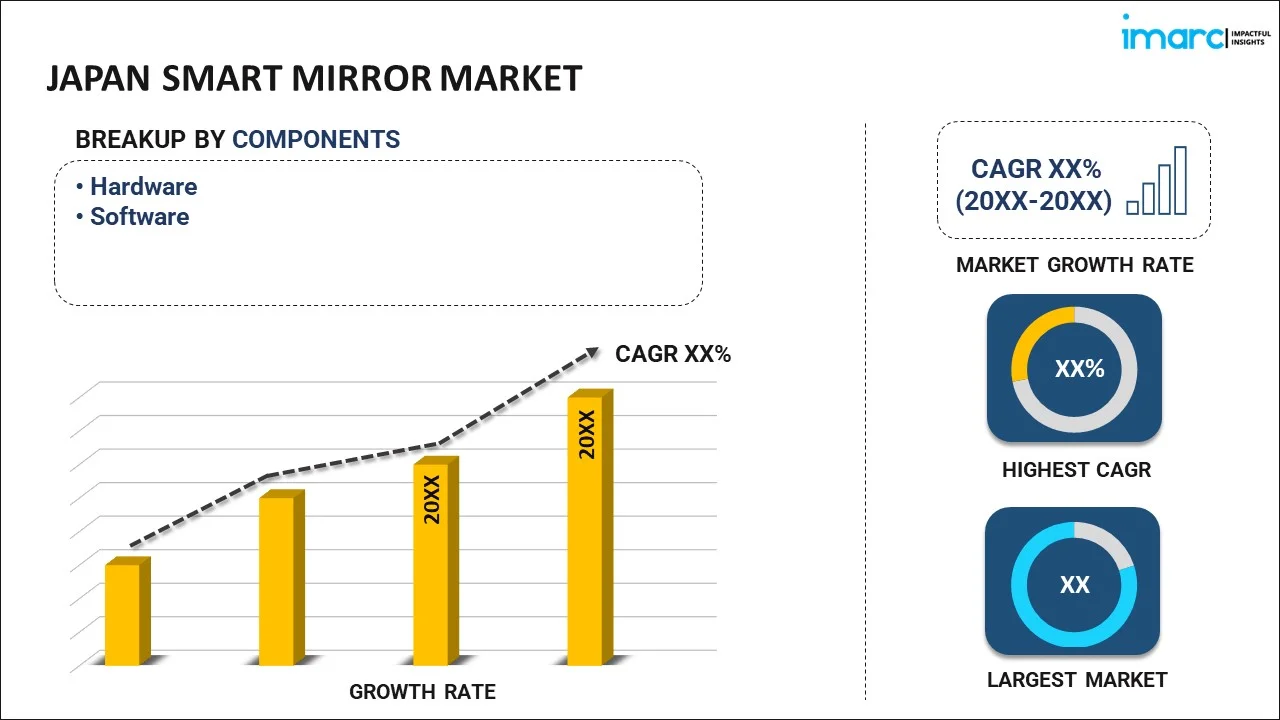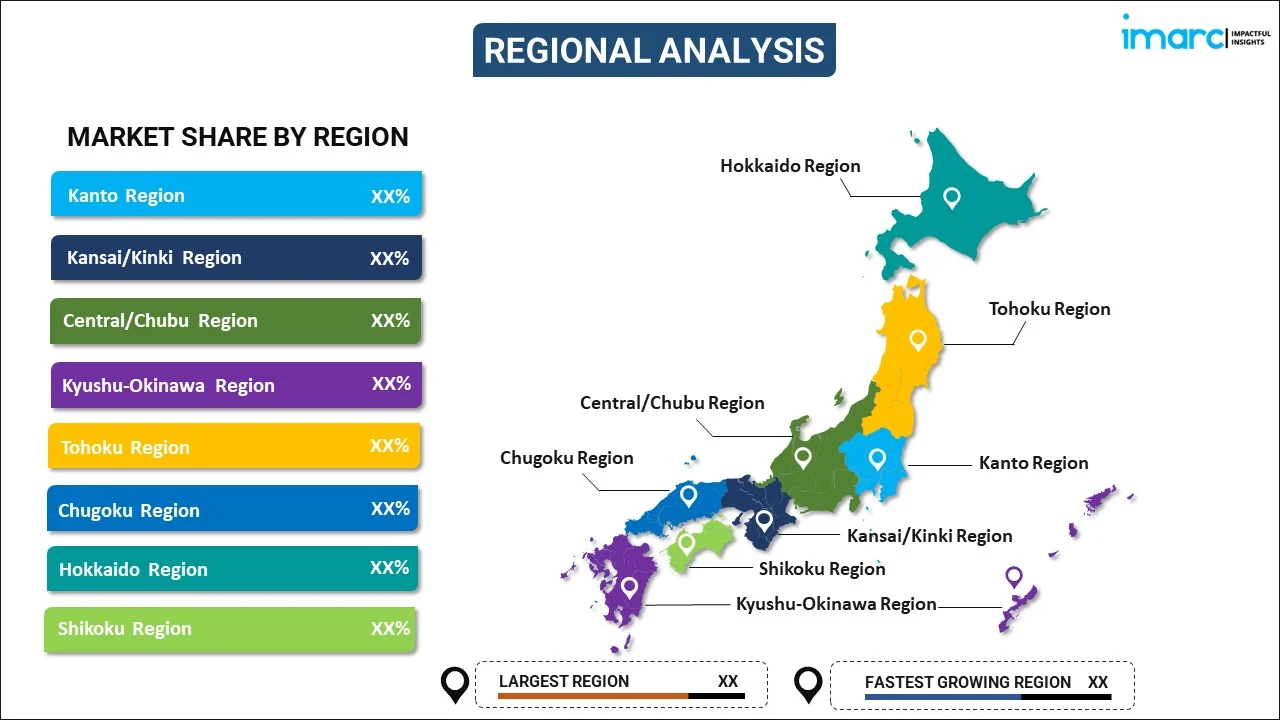
Japan Smart Mirror Market Report by Component (Hardware, Software), Type (Interior Mirrors, Exterior Mirrors), Functionality (Connected Mirror, Non-Connected Mirror), Technology (Self-Dimming, Self-Cleaning, Self-Repairing), End User (Automotive, Healthcare, Residential, and Others), and Region 2025-2033
Market Overview:
Japan smart mirror market size reached USD 258.5 Million in 2024. Looking forward, IMARC Group expects the market to reach USD 556.7 Million by 2033, exhibiting a growth rate (CAGR) of 8.46% during 2025-2033. Continuous advancements in the automotive industry to enhance the safety of the driver and the passengers are primarily driving the market growth.
|
Report Attribute
|
Key Statistics
|
|---|---|
|
Base Year
|
2024 |
|
Forecast Years
|
2025-2033 |
|
Historical Years
|
2019-2024
|
| Market Size in 2024 | USD 258.5 Million |
| Market Forecast in 2033 | USD 556.7 Million |
| Market Growth Rate (2025-2033) | 8.46% |
A smart mirror is an innovative two-way digital mirror equipped with advanced sensors, cameras, electronic displays, and connectivity systems. It features internet, Bluetooth, and Wi-Fi connectivity, along with touchscreen capabilities, enabling it to receive phone calls, access smartphone applications, and offer users an interactive experience. These smart mirrors are also equipped with built-in light emitting diode (LED) lights that offer adjustable color and warmth settings to provide optimal lighting based on user preferences. The display unit can show various information such as the date, time, weather forecast, news updates, and upcoming events and appointments directly on the mirror's surface. These mirrors possess self-dimming, self-cleaning, and self-repairing capabilities, in addition to being waterproof and scratch-resistant, making them suitable for a wide range of applications in industries like automotive, advertising, retail, residential, and healthcare, catering to both informational and entertainment needs.
Japan Smart Mirror Market Trends:
In the context of the Japanese market, significant growth in the automotive industry on a wide scale stands out as a primary driver for a promising market outlook. Smart mirrors are increasingly integrated into passenger and light-commercial vehicles equipped with advanced driver assistance systems (ADAS), serving the crucial role of providing blind spot vision and thereby enhancing driver and passenger safety. Furthermore, the rapid digitization trends observed in the retail sector are playing a pivotal role in propelling market growth. Retailers and fashion brands, for instance, are widely adopting smart mirrors in fitting rooms to offer consumers a comprehensive 360-degree view of outfits, thereby providing a digital shopping experience. Shoppers can interact with these mirrors to adjust lighting and receive styling recommendations, enhancing their overall shopping experience. Moreover, various technological advancements, such as the development of smart mirrors integrated with the Internet of Things (IoT) and artificial intelligence (AI) solutions, are contributing significantly to market expansion. Apart from this, the increasing spending capacity of consumers and extensive research and development (R&D) efforts are projected to fuel the regional market in the coming years.
Japan Smart Mirror Market Segmentation:
IMARC Group provides an analysis of the key trends in each segment of the market, along with forecasts at the country level for 2025-2033. Our report has categorized the market based on component, type, functionality, technology, and end user.
Component Insights:

- Hardware
- Software
The report has provided a detailed breakup and analysis of the market based on the component. This includes hardware and software.
Type Insights:
- Interior Mirrors
- Exterior Mirrors
A detailed breakup and analysis of the market based on the type have also been provided in the report. This includes interior mirrors and exterior mirrors.
Functionality Insights:
- Connected Mirror
- Non-Connected Mirror
The report has provided a detailed breakup and analysis of the market based on the functionality. This includes connected mirror and non-connected mirror.
Technology Insights:
- Self-Dimming
- Self-Cleaning
- Self-Repairing
A detailed breakup and analysis of the market based on the technology have also been provided in the report. This includes self-dimming, self-cleaning, and self-repairing.
End User Insights:
- Automotive
- Healthcare
- Residential
- Others
The report has provided a detailed breakup and analysis of the market based on the End user. This includes automotive, healthcare, residential, and others.
Regional Insights:

- Kanto Region
- Kansai/Kinki Region
- Central/ Chubu Region
- Kyushu-Okinawa Region
- Tohoku Region
- Chugoku Region
- Hokkaido Region
- Shikoku Region
The report has also provided a comprehensive analysis of all the major regional markets, which include Kanto Region, Kansai/Kinki Region, Central/ Chubu Region, Kyushu-Okinawa Region, Tohoku Region, Chugoku Region, Hokkaido Region, and Shikoku Region.
Competitive Landscape:
The market research report has also provided a comprehensive analysis of the competitive landscape. Competitive analysis such as market structure, key player positioning, top winning strategies, competitive dashboard, and company evaluation quadrant has been covered in the report. Also, detailed profiles of all major companies have been provided.
Japan Smart Mirror Market Report Coverage:
| Report Features | Details |
|---|---|
| Base Year of the Analysis | 2024 |
| Historical Period | 2019-2024 |
| Forecast Period | 2025-2033 |
| Units | Million USD |
| Scope of the Report | Exploration of Historical Trends and Market Outlook, Industry Catalysts and Challenges, Segment-Wise Historical and Future Market Assessment:
|
| Components Covered | Hardware, Software |
| Types Covered | Interior Mirrors, Exterior Mirrors |
| Functionalities Covered | Connected Mirror, Non-Connected Mirror |
| Technologies Covered | Self-Dimming, Self-Cleaning, Self-Repairing |
| End Users Covered | Automotive, Healthcare, Residential, Others |
| Regions Covered | Kanto Region, Kansai/Kinki Region, Central/ Chubu Region, Kyushu-Okinawa Region, Tohoku Region, Chugoku Region, Hokkaido Region, Shikoku Region |
| Customization Scope | 10% Free Customization |
| Post-Sale Analyst Support | 10-12 Weeks |
| Delivery Format | PDF and Excel through Email (We can also provide the editable version of the report in PPT/Word format on special request) |
Key Questions Answered in This Report:
- How has the Japan smart mirror market performed so far and how will it perform in the coming years?
- What has been the impact of COVID-19 on the Japan smart mirror market?
- What is the breakup of the Japan smart mirror market on the basis of component?
- What is the breakup of the Japan smart mirror market on the basis of type?
- What is the breakup of the Japan smart mirror market on the basis of functionality?
- What is the breakup of the Japan smart mirror market on the basis of technology?
- What is the breakup of the Japan smart mirror market on the basis of end user?
- What are the various stages in the value chain of the Japan smart mirror market?
- What are the key driving factors and challenges in the Japan smart mirror?
- What is the structure of the Japan smart mirror market and who are the key players?
- What is the degree of competition in the Japan smart mirror market?
Key Benefits for Stakeholders:
- IMARC’s industry report offers a comprehensive quantitative analysis of various market segments, historical and current market trends, market forecasts, and dynamics of the Japan smart mirror market from 2019-2033.
- The research report provides the latest information on the market drivers, challenges, and opportunities in the Japan smart mirror market.
- Porter's five forces analysis assist stakeholders in assessing the impact of new entrants, competitive rivalry, supplier power, buyer power, and the threat of substitution. It helps stakeholders to analyze the level of competition within the Japan smart mirror industry and its attractiveness.
- Competitive landscape allows stakeholders to understand their competitive environment and provides an insight into the current positions of key players in the market.
Need more help?
- Speak to our experienced analysts for insights on the current market scenarios.
- Include additional segments and countries to customize the report as per your requirement.
- Gain an unparalleled competitive advantage in your domain by understanding how to utilize the report and positively impacting your operations and revenue.
- For further assistance, please connect with our analysts.
 Inquire Before Buying
Inquire Before Buying
 Speak to an Analyst
Speak to an Analyst
 Request Brochure
Request Brochure
 Request Customization
Request Customization




.webp)




.webp)












